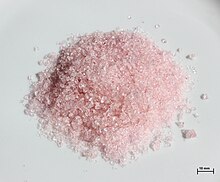Desiccant
Desiccants are substances that remove water or (less often) other solvents. The water can be chemically bound, for example in the case of sulfuric acid , calcium chloride or phosphorus pentoxide , or drying can take place by adsorption , such as in the case of molecular sieves or bentonite . A distinction is made between static and dynamic drying. In static drying, the drying agent is added to the substance to be dried and then removed again; in dynamic drying, the gaseous or liquid substance to be dried flows through the drying agent. Desiccants are used in industry to dry materials in the course of production, to protect end products from undesired soaking, or as a chemical agent against physically caused water release or condensation. This serves to ensure the longevity of a product, as it also causes corrosion and undesirable surface changes Material can be avoided.
The most frequently used drying agent is air, more precisely air with low relative humidity . One speaks of air drying. This is used in almost all areas of manual or industrial production.
Examples:
- Drying wood in instrument making or the furniture industry .
- Drying of food as a means of preservation (dried fruits, dried mushrooms, pastirma ).
- Drying textiles on the clothesline.
- Fluidized bed drying of sodium chloride (salt).
Chemical compounds with a special internal structure are also often used as drying agents. They are used to protect parts or high-quality components of a product from corrosion or condensation from water vapor .
Such means are e.g. B. silica gel or zeolites . In organic chemistry laboratories, anhydrous sodium sulfate or magnesium sulfate are often used as drying agents. Due to their chemical and structural nature, these include water molecules and then change their spatial molecular structure through intermolecular forces. Water molecules can no longer escape from the structure and remain bound. These drying agents can be regenerated by the action of heat, the bound water is driven out and the drying agent can be reused. Blue gel also consists of silica gel, but contains an indicator dye [cobalt (II) chloride], which indicates the degree of water absorption (blue = dry or pink = moist). Orange gel is also based on silica gel as a desiccant, just another indicator is used to indicate further usability.
For particularly high demands on the dryness of solvents (example: diethyl ether ), freshly pressed (bare) sodium wire is used for drying. The sodium reacts irreversibly with water residues to form sodium hydroxide and gaseous hydrogen .
Other frequently used drying agents are: aluminum oxide (regenerable), calcium , calcium hydride , calcium oxide , calcium sulfate (regenerable), potassium carbonate (regenerable), potassium hydroxide , copper sulfate , lithium aluminum hydride , sodium hydroxide.
There have also been attempts to use silica gel to compensate for buoyancy in airships in order to replace the mass of fuel used by absorbing water from the air.
application
Desiccants are necessary for:
- Keeping optical, precision mechanical and electronic components dry
- during transport within the packaging
- for keeping closed volumes dry (housing, optical components, laser)
- Desiccant in the space between the panes of insulating glass
- Solvent drying in the chemical laboratory
- Keeping air conditioning and other cooling systems dry
- Keeping packaged pharmaceuticals dry
Solvent drying in the chemical laboratory
Typical desiccants and their special features
- Anhydrous calcium chloride is a very popular desiccant because it is inexpensive, has a large water storage capacity, and quickly removes water from hydrocarbons. Calcium chloride anhydrous is used in the form of colorless pellets; After prolonged or improper storage, the pellets can disintegrate into fine calcium chloride dust, this dust can get through filter paper together with the solvent and thus contaminate the solvent. Anhydrous calcium chloride tends to form crystal alcohols, so it cannot be used to dry alcohols.
- Anhydrous sodium carbonate and anhydrous potassium carbonate are useful drying agents for basic solvents. They have a medium water storage capacity and a medium removal rate. These drying agents should not be used with acidic solvents.
- Sodium sulfate anhydrous is a neutral desiccant that has a high capacity for water. Drying takes a long time, but sodium sulfate is inexpensive. When water is absorbed, a granular hydrate forms, which can be easily filtered off. Sodium sulfate loses water above a temperature of 32 ° C, so the solvent temperature must be observed.
- Magnesium sulfate anhydrous is a good all-round desiccant that has a high capacity for water. Solvents are dried relatively quickly. Since it is used as a fine powder, there is a risk that the products of a synthesis will adsorb on the surface when a product-solvent mixture is to be dried, by washing with fresh, dry solvent it is possible to recover some product. Use a different drying agent for sensitive, acidic solvents or product-solvent mixtures.
- Anhydrous calcium sulfate is a neutral all-round desiccant with a low water storage capacity (only 0.05 g water per g CaSO 4 ) but quick absorption. It is sold under the brand name "Drierit" ("Drierite" in the English-speaking world), which can be purchased with and without an indicator (cobalt (II) chloride).
See also
Individual evidence
- ^ Brockhaus ABC Chemie , VEB F. A. Brockhaus Verlag, Leipzig 1965, pp. 1440–1441.
- ↑ a b c d e f g h i j k l m n Joaquín Isac-García, José A. Dobado, Francisco G. Calvo-Flores, Henar Martínez-García: Experimental organic chemistry: laboratory manual . 1st edition. Academic Press, London, ISBN 978-0-12-803935-9 .
- ↑ Zeno: Lexicon entry on "crystal alcohol". Meyers Großes Konversations-Lexikon, Volume 11 ... Retrieved May 22, 2019 .
- ↑ David R. Burfield: Desiccant efficiency in solvent and reagent drying. 9. A reassessment of calcium sulfate as a drying agent . In: The Journal of Organic Chemistry . tape 49 , no. October 20 , 1984, p. 3852-3854 , doi : 10.1021 / jo00194a043 .



